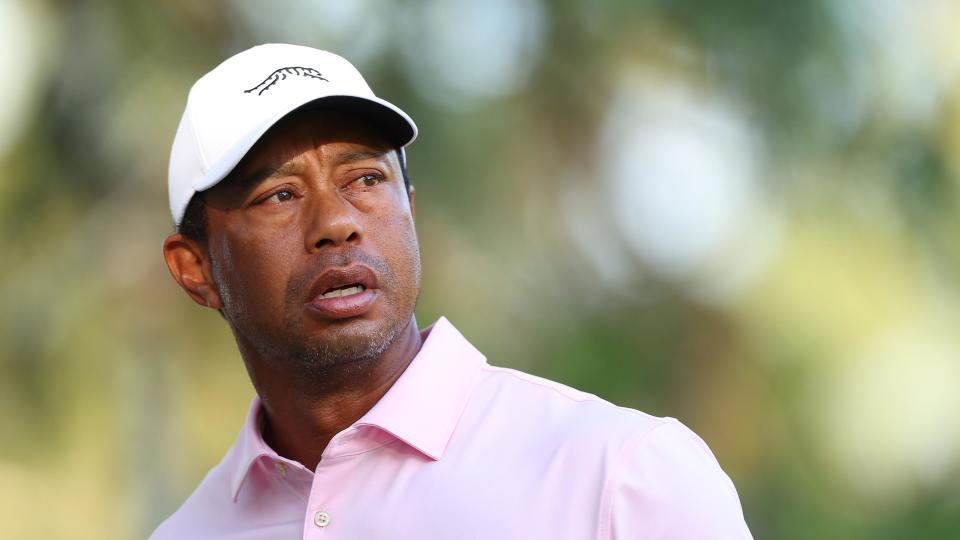The US Open prides itself on being ‘golf’s toughest test’ and Tiger Woods is expecting another “war of attrition” this week at Pinehurst.
Only four players have ended under par in three previous US Opens held at the North Carolina resort’s Number Two course.
And this week’s 124th staging of golf’s second oldest major looks set to be equally as challenging, with the speed of the ‘upturned saucer’ greens a huge talking point.
Defending champion Wyndham Clark said on Monday they were already “borderline” in terms of being too quick to putt on, while three-time winner Woods said on Tuesday that, like many other players in practice, he had “putted off lots of greens”.
“It depends how severe the USGA wants to make this,” added Woods. “But I foresee, just like in 2005, watching some of the guys play ping-pong back and forth [across the greens]. It could happen.”
The United States Golf Association (USGA), which runs the US Open, will be keen to avoid a repeat of that, or what happened at Shinnecock Hills in 2004 and 2018 during a week when temperatures are forecast to be above 30C.
The USGA was accused of “losing the course” by Woods in 2004 after it failed to water greens after round two. Greenstaff were forced to hose down the putting surface on the seventh hole between groups in the final round because it had become largely unplayable.
In 2018 Phil Mickelson hit his ball while it was still moving on the 13th hole at Shinnecock as the USGA was again criticised over its course set-up.
‘Round one lead could be winning score’
Woods, 48, was in his prime when he played the first two US Opens at Pinehurst in 1999 and 2005.
He finished third in the first, when the late Payne Stewart was the only man to beat par. Six years later Woods missed out on what would have been his 10th major when he bogeyed the 16th and 17th holes in the final round and was runner-up by two shots to New Zealand’s Michael Campbell, who won on level par.
Woods was absent with a back injury when Germany’s Michael Kaymer romped to an eight-shot victory in 2014 on a course that had undergone huge renovations.
The US Open staple heavy rough and narrow fairways were stripped away, leaving sandy ‘native areas’ and ‘turtleback’ greens as the course’s defence.
However, Americans Rickie Fowler and Erik Compton were the only other players to break par as Kaymer, who had been 10 under after round one, triumphed on nine under.
And Woods can see a similar theme developing this year.
“This could be one of the Opens where whatever the leading score is [after round one]that’s probably as low as we’ll ever go,” said the 15-time major champion.
“We were half joking that by the end of the week it might be one of those when the greens get so slick that you bend down to read a putt or bend down to fix a ball mark and your putter slips.”
The course, designed by legendary architect Donald Ross, who grew up playing and working on the fabled links of Dornoch in northern Scotland in the 19th Century, was opened for play in 1907.
He had worked with Old Tom Morris in Scotland around the turn of the 20th Century and, with only wheelbarrows and spades to move earth, their courses are typified by being largely styled by nature.
“When Donald did this golf course and made the greens this severe, I don’t think he intended it to be running at 13 on the stimpmeter (a device used to measure green speed),” said Woods.
“They were the speed of fairways. They’re very severe and we’re playing under faster conditions.
“It’s more of a test. It’s going to be a great test and a great war of attrition this week. It’s going to be a lot of fun for all of us.”
‘Run-off areas lead to more excitement for fans’
The green surrounds are also provoking much debate between players as to whether they negotiate the steep run-offs with putters, wedges, irons or even fairway woods.
Rory McIlroy thinks the variety of shots players will have to conjure up will make “viewing more exciting” for the fans “rather than seeing guys hack out of four-inch rough all the time”, as happens on the PGA Tour.
Speaking on Tuesday, the 2011 champion from Northern Ireland said he had “36 hours” to “figure out what I’m comfortable with around the greens”.
It is a view shared by world number one Scottie Scheffler, who said he “appreciates more having the playability of the run-off areas more than heavy rough surrounding every green”.
“It provides a little bit more variety, a little bit more excitement and a little bit more creativity around the greens,” said the two-time major winner.
“It’s a better test than just having heavy rough over the back of every green.”
Woods says he has ruled out using woods, while 2020 champion Bryson DeChambeau is favouring his wedges, “hitting into the slope and bouncing it up and rolling it over the top of hills” unless he gets a bad lie, in which case he is putting.
Norway’s rising star Viktor Hovland says he is leaning more towards the putter.
“If you take an average of 20 shots, the putter is going to be way better than the chip,” he said. “Maybe it will be somewhere close to 60-40 with putter.”
Xander Schauffele, who won his first major at last month’s US PGA Championship, says he “typically defaults to putting”.
“The Texas wedge is definitely my friend,” he said. “I’ve never hit so many putts. I joked with my caddie I should get it checked out. I’ve never swung so hard on my putter for nine holes, just trying to get up and down mounds.”
However, Kaymer, who famously putted superbly from on and off the green on his way to victory a decade ago, says his approach this week “might be a little bit different”.
“I might be using the rescue a little bit more often or the hybrid around the greens because of the length of the grass,” he said.
“It’s a little bit higher, a little bit thicker, so it’s not as tight as it used to be.”
And that is coming from the only man to reach double digits under par in a US Open at Pinehurst Number Two.







